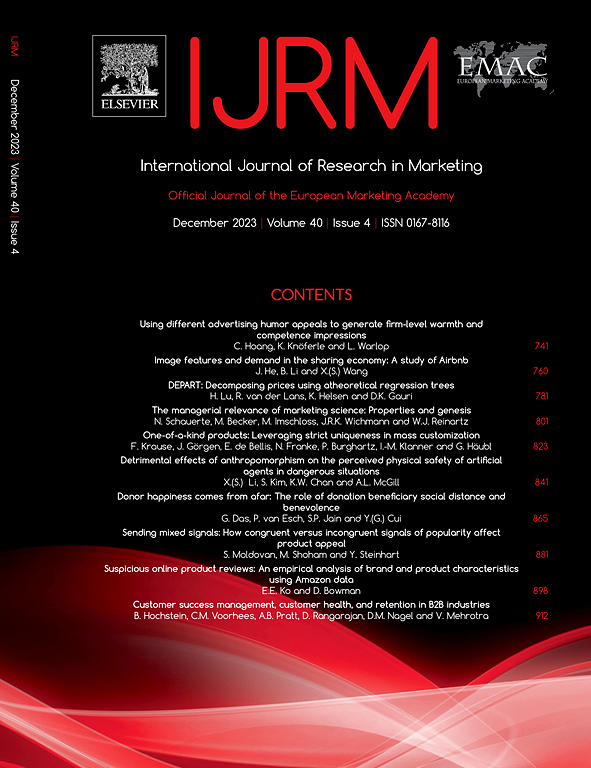The contingent effects of innovative digital sales technologies on B2B firms’ financial performance
IF 7.5
2区 管理学
Q1 BUSINESS
International Journal of Research in Marketing
Pub Date : 2024-12-01
DOI:10.1016/j.ijresmar.2024.05.004
引用次数: 0
Abstract
Business-to-business (B2B) firms make large investments to implement innovative digital sales technology (IDST) in the hope of increasing firm performance. While marketing research generally indicates that these investments should pay off, recent experiences from managerial practice suggest that such beneficial payoffs may not necessarily arise. To examine the effects of implementing IDSTs on B2B firm performance, we differentiate between customer-sensing and customer-linking IDSTs: while customer-sensing IDST has the primary purpose of identifying new sales opportunities (e.g., predictive analytics) early within the B2B sales funnel, the purpose of customer-linking IDST (e.g., augmented reality application) is to close sales opportunities. The results of a multi-data study involving 314 B2B firms confirm that implementing customer-sensing and customer-linking IDST can exhibit a complementary, positive effect on firm profit, but this effect strongly varies with the sales task environment in terms of firms’ offering and demand complexity. In unfavorable conditions, extensive digitalization in B2B sales can even harm firm profit. These findings contribute to sales technology research and the literature on marketing capabilities and guide managers on how to ensure successful sales digitalization.
创新数字销售技术对 B2B 企业财务业绩的或然效应
企业对企业(B2B)公司投入大量资金来实施创新的数字销售技术(IDST),以期提高公司绩效。虽然市场研究普遍表明,这些投资应该得到回报,但最近管理实践的经验表明,这种有益的回报可能不一定会出现。为了检验实施IDST对B2B公司绩效的影响,我们区分了客户感知和客户链接IDST:客户感知IDST的主要目的是在B2B销售漏斗的早期识别新的销售机会(例如,预测分析),而客户链接IDST(例如,增强现实应用)的目的是关闭销售机会。一项涉及314家B2B公司的多数据研究结果证实,实施客户感知和客户链接的IDST可以对企业利润表现出互补的积极影响,但这种影响在企业提供和需求复杂性方面的销售任务环境中表现出强烈的差异。在不利的情况下,B2B销售中广泛的数字化甚至会损害公司的利润。这些发现有助于销售技术研究和营销能力的文献,并指导管理者如何确保成功的销售数字化。
本文章由计算机程序翻译,如有差异,请以英文原文为准。
求助全文
约1分钟内获得全文
求助全文
来源期刊
CiteScore
11.80
自引率
4.30%
发文量
77
审稿时长
66 days
期刊介绍:
The International Journal of Research in Marketing is an international, double-blind peer-reviewed journal for marketing academics and practitioners. Building on a great tradition of global marketing scholarship, IJRM aims to contribute substantially to the field of marketing research by providing a high-quality medium for the dissemination of new marketing knowledge and methods. Among IJRM targeted audience are marketing scholars, practitioners (e.g., marketing research and consulting professionals) and other interested groups and individuals.

 求助内容:
求助内容: 应助结果提醒方式:
应助结果提醒方式:


